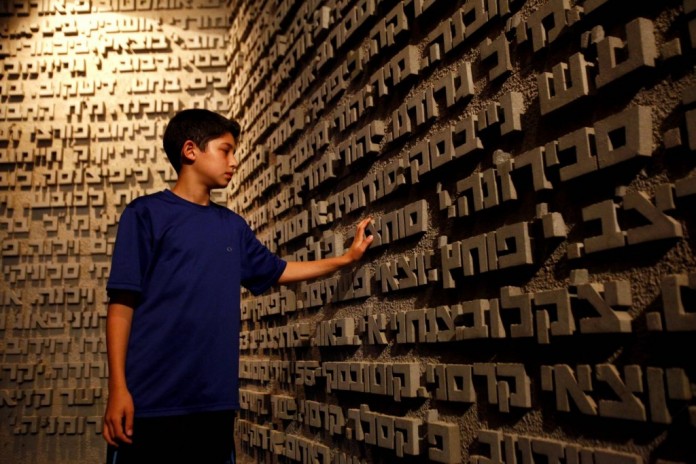
The Amud Aish Memorial Museum’s (Amud Aish) Kleinman Holocaust Education Center division is introducing its third annual exhibition program and workshop for school groups: Hidden Children and the Holocaust which highlights previously untold stories of survival, heroism, sacrifice, loss, and faith against all odds—from the perspective of the children who went through it. The program will allow students to learn about children who were brave beyond their years; discover the objects children chose to take with them into hiding; discuss the efforts of rescuers looking to find the hidden children; and explore complex issues of identity and responsibility.
“We are presenting this exhibition through the eyes of children so that the students who visit can connect with the stories, understand the experiences of those who lived through the Holocaust, and be moved deeply by what they learn,” said Julie Golding, Director of Education. “During the tour and workshop, we focus on teaching the fourth generation through objects and survivor testimony.”
The children who survived the Holocaust typically could do so because they were in hiding. They hid in plain sight by assuming new identities with non-Jewish families; they hid under floorboards and in barn lofts; they lived in sanctioned orphanages; or their parents sent them to safety via the Kindertransport. The museum presents artifacts and documents from the time these children were in hiding through the attempts by family members and the community to rescue them after the war.
The exhibit explores the dilemma of Jewish families faced with deciding whether or not to hide their children, how, and with whom.
“Of the six million Jewish Holocaust victims, 1.1 million were children. This time period was particularly harrowing for children and required families to make unimaginable choices and sacrifices,” said Rabbi Sholom Friedmann, Director of Amud Aish. “Studying children’s experiences during the Holocaust is an important way to teach students about the Holocaust because children relate to other children.”
This year’s education program includes a workshop, “Life in an Envelope”, about a hidden child. In 1941, Lucienne Stieglitz Stillman’s parents entrusted their infant daughter to their non-Jewish friends, hoping she would be protected from the Nazis. Soon after, Lucienne’s parents were deported and murdered. Lucienne survived the war and in 1947 her uncle tried to retrieve her. He was unsuccessful: her adoptive parents would not release her and the Belgian government supported them. When she was 21 years old, a cousin found her and accompanied her on a planned six week visit to New York to meet her real family. She never returned to Belgium, having found her faith and her future husband in New York. The students in the workshop will employ Lucienne’s testimony as well as personal documents and artifacts from her life to delve into her experience and her sense of never belonging—being in two worlds—because she was a hidden child.
The education department has also incorporated a new art workshop into the school visits. This new program, called “A Life Remembered”, teaches students about art that was created by children during the Holocaust. Students learn about an autograph book that belonged to Jenny Feldman who died in the Holocaust. It was given to her cousin Goldine Ehrenfeld after the war, and she continued to use it. The artwork in the book is vivid, colorful, and happy—expressing the hope and meaning in these children’s lives. In the workshop, students reflect on these pieces of art and use various materials to create a memorial to the children of the Holocaust.
The Amud Aish school program in Mill Basin, Brooklyn, accommodates grades 6 through 12. School visits are content-rich experiences that support the New York State social studies standards and align with Common Core Standards. Museum educators provide resources to teachers in advance of each visit to prepare students for the experience and encourage learning beyond the field trip. Tours are available in English, Hebrew, and Yiddish. The online group reservation system is currently taking requests at http://www.amudaish.org/group. In 2015, many thousands of children visited the school exhibition program.
About the Amud Aish Memorial Museum/Kleinman Holocaust Education Center
Amud Aish is dedicated to documenting the micro-histories of observant Jewish victims and the role of faith within the broader context of the annihilation of European Jewry. It will service the general public and students at its soon-to-open permanent museum location that incorporates the Kleinman Holocaust Education Center, the Orthodox Testimony Project (in partnership with the United States Holocaust Memorial Museum), a document and research archive, and an artifact collections archive. Amud Aish is active globally through its International Division, with current projects in Poland and Belgium and more in development. Amud Aish will open its permanent location in Boro Park, Brooklyn, in 2017. It currently has a temporary facility in Mill Basin, Brooklyn, with future annexes in Lakewood, New Jersey, and Jerusalem. Learn more at amudaish.org and follow us on Facebook: @amudaishmm.












Thanks Elly Kleinman for providing us with an opportunity to visit such an exceptional museum.